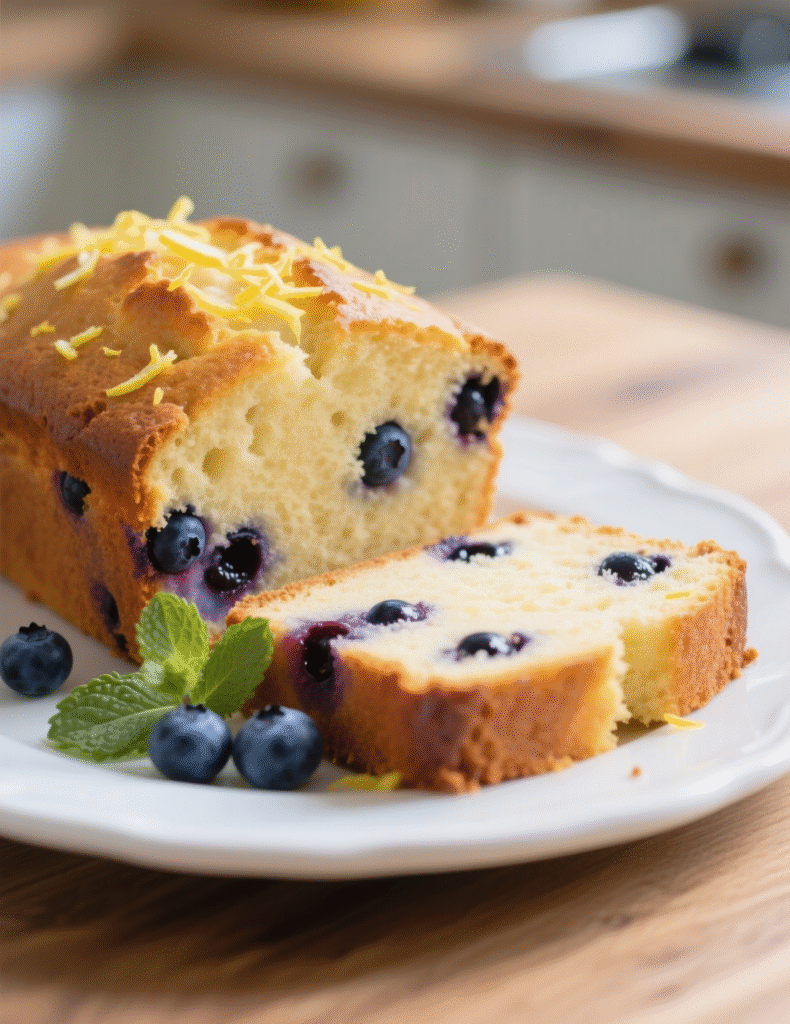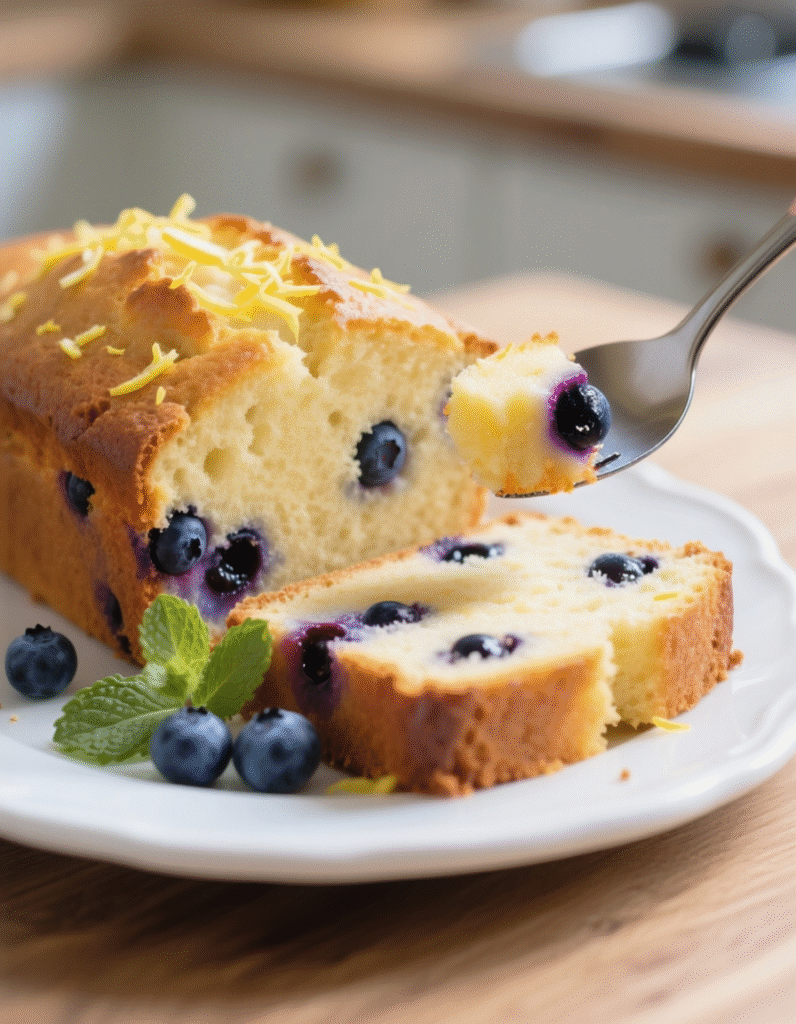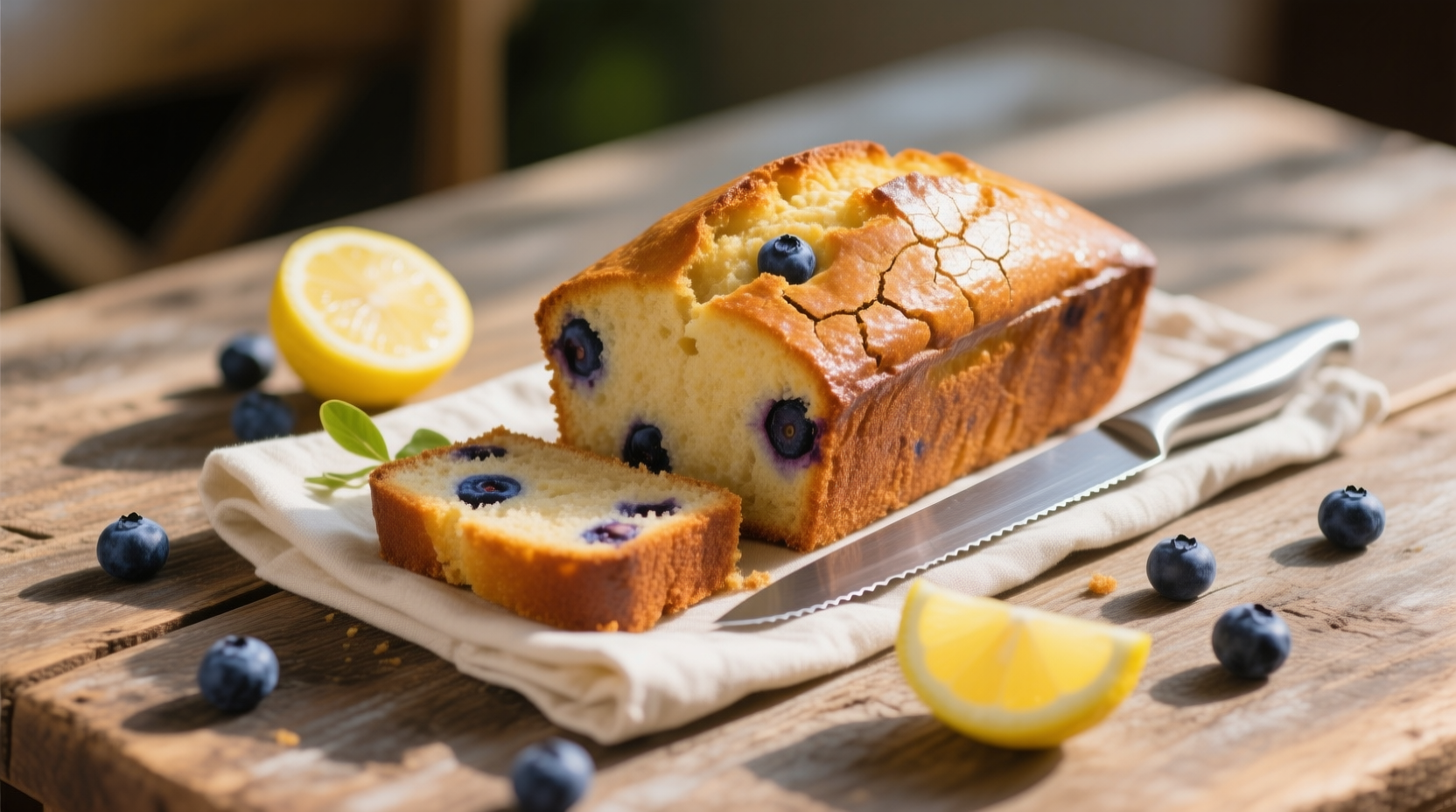A lemon blueberry loaf sounds simple. And yes, anyone can throw flour, sugar, and berries together. But crafting a loaf that slices clean, carries a moist crumb, and keeps its bright citrus tang without sinking blueberries is another story. That’s where a little precision meets a bit of play. This guide digs deeper than your average recipe post, pulling in techniques, science, and even a few pro tips that bakers rarely share.
Why This Loaf Matters
The lemon blueberry loaf sits in that sweet middle ground between quick bread and cake. It’s not dense like banana bread, and not airy like a sponge. It carries the structure of a pound cake but remains tender thanks to the balance of fats and acidity. Professional pastry chefs love it because it shows control: citrus zest mustn’t overpower, blueberries shouldn’t bleed, and the loaf should keep shape for days. When done right, you get something that looks effortless but whispers of craft.
The Backbone of Flavor: Lemon
Lemon isn’t just flavoring here—it’s architecture. Its acidity reacts with leavening agents, giving the loaf lift. But the real treasure lies in the zest. Those tiny oil-packed sacs on the peel carry more aroma than the juice ever will. A study published in the Journal of Agricultural and Food Chemistry notes that lemon peel oil carries over 300 volatile compounds, many of which release during baking, creating that bright, fresh hit. That’s why zest should be rubbed directly into the sugar before mixing—it coaxes oils out and distributes them evenly. Professionals call this “fragrant sugar” and it’s a game changer.
The Role of Blueberries
Blueberries complicate things. They’re heavy, they leak juice, and if handled poorly, they’ll sink to the bottom or stain the crumb into a gray mess. Tossing berries lightly in flour is the oldest trick, but it’s not magic. The batter itself must have enough viscosity to suspend them. Fresh firm berries work best, though frozen can be used if added straight from the freezer to prevent bleeding. A professional tweak? Freeze half your berries, fold them in last. They’ll hold shape better and scatter more evenly through the loaf.
Flour, Fat, and Balance
A loaf like this demands all-purpose flour. Cake flour makes it too fragile, bread flour too chewy. All-purpose offers the right protein level—around 10 to 11%—to build structure without making the loaf tough. For fat, butter brings richness and flavor, but oil keeps it moist for longer. Many professional recipes now combine both: butter for depth, oil for longevity. The split can be 70/30 depending on preference. The result is a loaf that tastes luxurious on day one and still tender on day three.
Sugar: Sweetness with Function
Sugar is more than sweetness. It tenderizes by interfering with gluten formation, helps brown the crust, and retains moisture. Some bakers cut it back, but reducing sugar too much destabilizes the crumb. Professional bakers often pair granulated sugar with a small portion of brown sugar to add a subtle caramel undertone. You don’t need much—just a tablespoon or two—to give depth without muddying the lemon.
Eggs: The Silent Builders
Eggs are structure in disguise. The proteins coagulate under heat, holding everything together. Yolks bring richness and emulsifiers, helping fat and water bind smoothly. Using room temperature eggs is non-negotiable—they whip and incorporate far more evenly. Ever wonder why bakery loaves slice so clean? It’s often because their eggs were tempered to just the right temperature before mixing, ensuring consistency.

Baking Science: Why Loaves Fail
Loaf baking comes with its pitfalls. Overmix the batter, and you activate gluten, leading to toughness. Underbake, and the center collapses as it cools. Baking too hot forces the edges to set while the middle still raw. A study by King Arthur Baking notes that the “sweet spot” for quick breads is typically 325–350°F, where heat penetrates steadily without scorching the crust. Professionals often use an oven thermometer rather than trust factory settings.
Building the Perfect Batter
Start by creaming butter, oil, and sugar with zest until pale. This aerates the mixture and builds the first stage of structure. Add eggs one at a time—this prevents splitting. Then alternate flour and dairy (buttermilk or yogurt works best), beginning and ending with flour. This layering keeps the batter stable and emulsified. Blueberries folded in last ensures minimal streaking. The batter should be thick enough to cling to a spoon, not run like pancake mix.
The Case for Buttermilk
Regular milk works fine, but buttermilk transforms the loaf. Its acidity tenderizes gluten and deepens the lemon tang. A paper in Food Hydrocolloids showed that cultured buttermilk lowers pH and improves crumb tenderness in baked goods. Yogurt can serve the same role if thinned slightly with milk. Many chefs now prefer Greek yogurt for its higher protein, which strengthens structure while still softening crumb.
The Glaze Question
Should you glaze? Purists sometimes argue the loaf should shine on its own. But a thin lemon glaze does two things: it locks moisture and doubles down on citrus notes. To avoid a sticky mess, glaze while the loaf is just warm, not hot. This allows the glaze to seep slightly but still set. Powdered sugar and fresh lemon juice in a near 2:1 ratio works. Add zest to the glaze if you want extra punch.
Common Mistakes Professionals See
Too much zest. It turns bitter. Use zest from only one large lemon unless you balance with sugar.
Overloading berries. More isn’t better; it destabilizes the crumb.
Cutting too soon. A hot loaf will crumble apart. Always rest 20 minutes before slicing.
Skipping pan prep. Grease and line with parchment or risk sticking, no matter how “nonstick” the pan claims.
Storage and Shelf Life
Unlike a chiffon cake, this loaf ages gracefully. Wrapped properly, it stays moist for up to 4 days at room temperature. Refrigeration can dry it, so unless your climate is humid, room temperature is safer. For longer storage, freeze in slices, wrap tightly, and thaw gently. Professional bakeries often flash-freeze loaves within hours of baking to preserve peak freshness.
Variations for Professionals
Infuse herbs like thyme or rosemary into the sugar before mixing for an elevated twist.
Swap blueberries with raspberries or blackberries for seasonal change.
Replace half the flour with almond flour for a nutty undertone and more moisture retention.
Add a swirl of cream cheese filling to turn it into more of a coffee cake hybrid.
A Few Industry Stats
According to the American Baking Association, fruit-based quick breads like lemon blueberry are among the top five most requested café items, right after banana bread and scones. Google Trends data also shows “lemon blueberry loaf” peaks in searches every spring, coinciding with berry season. Professional bakeries often capitalize on this, featuring it as a seasonal menu item to drive repeat customers.

The Recipe (Professional Adaptation)
- 1 ½ cups all-purpose flour
- 1 tsp baking powder
- ½ tsp salt
- ½ cup unsalted butter, softened
- ¼ cup neutral oil
- 1 cup granulated sugar
- Zest of 1 large lemon
- 2 large eggs, room temp
- ½ cup buttermilk (or yogurt, thinned)
- 2 tbsp lemon juice, fresh
- 1 cup blueberries (fresh or frozen)
Glaze:
- ½ cup powdered sugar
- 1 tbsp lemon juice
- Zest, optional
Method:
- Preheat oven to 350°F. Grease and line loaf pan.
- Whisk flour, baking powder, and salt together.
- Rub zest into sugar until fragrant. Beat with butter and oil until pale.
- Add eggs one at a time. Mix in lemon juice.
- Alternate dry ingredients with buttermilk, starting and ending with flour.
- Fold in blueberries lightly.
- Pour into pan. Bake 50–60 minutes until toothpick comes out clean.
- Cool 15 minutes. Drizzle glaze while still slightly warm.
Conclusion
An easy homemade lemon blueberry loaf recipe isn’t just kitchen play—it’s chemistry, timing, and control. Professionals know it’s the little tweaks that separate a dry, sinking loaf from one that slices like silk and bursts with flavor. Think balance: lemon’s brightness, blueberries’ sweet bite, butter’s richness. That’s what makes this loaf endure in both home kitchens and bakery counters. Bake it once with care, and it may just become your signature.
FAQs
Can I use frozen blueberries in the loaf?
Yes, just add them straight from the freezer to prevent bleeding into the batter.
Why do my blueberries sink to the bottom?
Your batter is likely too thin; a thicker batter helps suspend the berries.
Do I need both butter and oil in this recipe?
Not required, but using both gives flavor from butter and longer moisture from oil.
Can I replace buttermilk with regular milk?
Yes, though buttermilk or yogurt gives better tenderness and tang.
How do I stop the loaf from turning bitter?
Avoid over-zesting; only use the yellow peel, not the white pith.
Should I glaze the loaf or not?
It’s optional, but a lemon glaze enhances flavor and seals in moisture.
How long does the lemon blueberry loaf stay fresh?
About 3–4 days at room temperature if wrapped properly.
Can I make this loaf gluten-free?
Yes, use a 1:1 gluten-free flour blend for best results.
Why does my loaf collapse in the middle?
It’s often underbaked or your oven temperature runs too hot.
Can I add other fruits instead of blueberries?
Absolutely, raspberries or blackberries make excellent substitutes.

Mariana is a passionate home cook who creates delicious, easy-to-follow recipes for busy people. From energizing breakfasts to satisfying dinners and indulgent desserts, her dishes are designed to fuel both your body and hustle.
When she’s not in the kitchen, she’s exploring new flavors and dreaming up her next recipe to share with the Foodie Hustle community.

